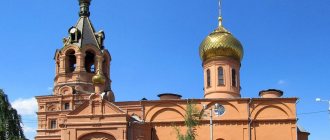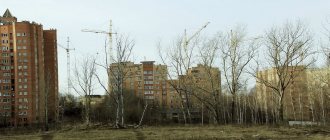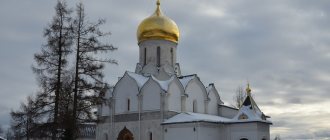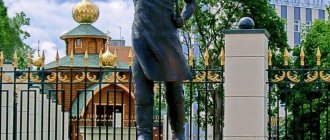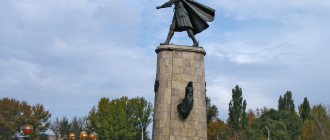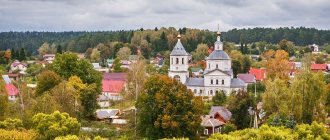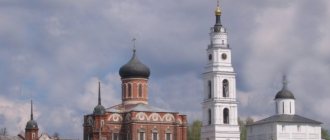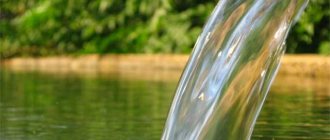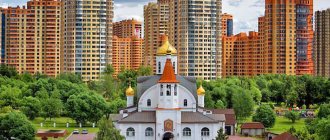So, a trip to Konstantinovo. I immediately apologize for the quality of the photos. I'm not a photographer, and my equipment is purely amateur. I just wanted to share my impressions. Early Sunday morning on June 16th of this year, 2013, we left home. We got to Ryazan in a breeze on a comfortable bus from Vykhino in less than 3 hours. We stayed at the Priokskaya Hotel. While we were riding on the bus to the hotel, the residents of Ryazan gave us advice on where to see things - what nice people! Grandfather talked about the underground passage on the territory of the Kremlin, remembered the times when boats flew to Konstantinovo, an aunt immediately joined in and talked about the airborne school, another aunt promised to indicate the right stop - in general, Ryazan welcomed us with open arms. We dropped off our things at the hotel and immediately headed to Sergei Alexandrovich’s native village. It turned out that getting to it from Ryazan is much more difficult than from Moscow to Ryazan. Buses go there only in the morning and in the evening - we, accordingly, did not have time for the before lunch, and it was not our plan to wait for the evening one. We decided to go to Rybnoye, from there it’s another 20 km to the village, but we thought maybe it would be easier with transport there. But no! While we were traveling in the bus, another kind Ryazan resident suggested that there are no buses from Rybnoye to Konstantinovo, and it would be better for us to get off “at the cross”, and there it is 5 km, and here it is - the gentle homeland. There is hope of catching a ride. We leave “at the cross.” “Hitchhikers” there rush at a minimum of 120 km/h and do not think about taking fellow travelers. We are doomed to walk 5 km. But nothing can stop true fans. And what a beauty! The road is in an open field, and there are no houses on the horizon. “Only blue sucks eyes” We wandered and wandered, having lost faith in kind-hearted car enthusiasts, resigning ourselves to the lot of meek travelers, and finally arrived.
We were greeted by a village with domestic cattle grazing wildly.
And here it is! Favorite region! The heart dreams of stacks of sun in the waters of the bosom. I would like to get lost in the greenery of your hundred-bellied greens. Along the border, on the edge, there is mignonette and a riza of porridge. And the meek nuns call Willow to the rosary. The swamp smokes like a cloud, Burnt smoke in the heavenly rocker. With a quiet secret for someone I hid thoughts in my heart. I meet everything, I accept everything, I am glad and happy to take out my soul. I came to this earth to leave it quickly.
Behind the mountains, behind the yellow valleys, a trail of villages stretches. I see a forest and an evening fire, And a hedge entwined with nettles. There, in the morning, over the church domes, the heavenly sand turns blue, and the roadside grasses ring from the lakes with a watery breeze. It is not for the songs of spring over the plain that the green expanse is dear to me - I fell in love with the melancholy of a crane On a high mountain a monastery. Every evening, as the blue clouds over, as the dawn hangs on the bridge, you go, my poor wanderer, to bow to love and the cross. The meek spirit of a monastery resident, You eagerly listen to the litany, Pray before the face of the Savior for my lost soul.
The terrain there is hilly, waist-deep grass. The hike along the Oka River was a good addition to our 5-kilometer run. Plus, the weather had cleared up, the sun was baking the tops of our heads, and the midges, which were there in abundance, were terribly happy about our appearance. But this is such nonsense compared to what we are lucky enough to breathe deeply and absorb with our eyes
life and death…
This street is familiar to me, And this low house is familiar. The wires of blue straw fell over the window. There were years of severe disasters, Years of violent, insane forces. I remembered my village childhood, I remembered the village blue. I did not seek either glory or peace, I am familiar with the vanity of this glory. And now, when I close my eyes, I see only my parents’ house. I see a garden dotted with blue, August quietly lay down against the fence. The linden trees are held in their green paws. Bird noise and chirping. I loved this wooden house, A menacing wrinkle glowed in the logs, Our stove howled somehow wildly and strangely on a rainy night. The voice is loud and sobbing, like talking about someone dead, alive. What did he see, a brick camel, in the howling of the rain? Apparently, he saw distant countries, The dream of another and blooming time, The golden sands of Afghanistan And the glass gloom of Bukhara. Oh, and I know these countries - I myself have walked a long way there. Only closer to my native land I would like to turn now. But that gentle slumber faded away, Everything decayed in blue smoke. Peace be with you - the straw of the field, Peace be with you - a wooden house!
View from the Yeseninsky yard
Sergun planted poplar
Neighbors of the Yesenins (residential house)
Zemstvo primary school, where little Seryozhka studied
The Kashins' estate
Well, the village, of course, is far from being in the form in which Sergun loved it: ideal lawns, tiled paths, restored buildings, exhibits covered with yellow ribbons - a tourist complex. Yesenin is alive on the banks of the Oka, in the present village his presence is faintly felt. After dinner at a restaurant around 8 pm, we set off for Ryazan. The last bus leaves from Konstantinovo to Ryazan at 20:00. We hoped that it would not be cancelled, however, when a taxi kindly stopped in front of us, offering to take us to the hotel entrance for 700 re, we could not refuse, remembering our heroic forced march. Moreover, the price for 40 km is frankly trivial. Crushed in room a bottle of cognac for the blessed memory of our Sergei Alexandrovich, we fell asleep closer to midnight. I slept great! The air of Ryazan is, indeed, somehow healing. We had breakfast and went for a walk around the city. On the morning of June 17 it’s +28, the sun is blazing hot! territory of the Ryazan Kremlin:
A little bit of Ryazan
Tame birds
and foot
get in line, you sons of bitches, get in line!
On June 17 at about 9 pm we are already in Pushkino. Wow, it turns out it’s so cold and rainy here!
History of creation
The idea to erect a monument to the beloved poet belonged to V. A. Zhukovsky, but due to harsh statements addressed to the emperor, Pushkin’s person was banned, so there could be no talk of any monument. Some time later, students of the Tsarskoye Selo Lyceum came up with a similar initiative.
And here, in order not to provoke a resonance in society, the authorities made concessions, but the lyceum students themselves had to raise funds to create a sculpture that would perpetuate the memory of their beloved poet. As a result, the initially collected amount of 13 thousand rubles was not enough for the monument. Then a student of the Lyceum, Yakov Grot, organized another fundraiser. This time they collected more than 160 thousand, which made it possible to begin work on the monument.
First of all, proactive lyceum students announced a national competition to create a project for a sculptural composition. The winner was the sculptor Alexander Opekushin. Architect Ivan Bogomolov was hired to work on the pedestal. The creative process lasted about five years. The sculpture itself was cast at the St. Petersburg Bronze Foundry, and the pedestal was made from Serdobol granite, mined in the north of Ladoga.
© Vladislav Kolmyagin
The opening of the monument to Alexander Sergeevich Pushkin was supposed to coincide with the anniversary of the founding of the Tsarskoye Selo Lyceum, October 19, 1879. But it turned out that one of the pedestal plates was damaged. Then the opening was postponed until next year, until Alexander Sergeevich’s birthday. But this time the opening did not take place: the country was in mourning for Empress Maria Alexandrovna. And only the third attempt to present the monument to Muscovites and guests of the capital was crowned with success: on June 18, 1880, despite inclement weather and rain, there was no crowd on Tverskoy Boulevard - Muscovites came to the opening ceremony of the monument to their beloved poet.
On the 100th anniversary of Pushkin’s death, Strastnaya Square was named Pushkinskaya; a year later, the Bolsheviks razed the Strastnoy Monastery from the face of the earth. And after another 12 years, the monument was turned so that it faced Tverskaya Street and erected in the place of the destroyed bell tower. This decision caused bewilderment and sometimes open indignation on the part of Muscovites. Therefore, even today, when several generations have become accustomed to seeing the bronze Pushkin on Pushkin Square, the idea of moving the monument to Tverskoy Boulevard still causes heated discussions.
© Irina Koshevaya
The night Watch
The first and largest composition is the Night Watch. Rembrandt's famous painting of the performance of a rifle company with their captain, now embodied in stone. Unlike the painting, the soldier can be viewed from all sides without the shadows present in the painting. You can even go inside and feel like a part of the story.
The painting itself once made a real revolution in portraiture. Before this, group portraits were painted with seated people in a ceremonial setting. The artist brought movement and everyday life into the plot.
The group represents two dozen figures of soldiers of the 17th century setting out on a campaign. Pikemen, skirmishers, standard bearer, drummer and officers. You can examine all the details of clothing and weapons on them. Among these warriors with muskets and bladed weapons in the colorful and fluffy clothes of musketeers, there is a little girl with a chicken carcass at her belt. This is Saskia, Rembrandt's first wife. A dog runs at the drummer’s feet, which tourists love to pet for good luck. You can't pet the drummer.
Description
The sculptor A. Opekushin recreated the poet as a curly-haired young man with characteristic sideburns, with a puzzled glance from under his brows, as if reflecting on his next work or entering into an argument with an invisible opponent. Alexander Sergeevich appears before us dressed in a frock coat and cloak, his left hand with his hat is behind his back, and his right hand is hidden behind the lapel of his cloak. It is interesting that in Opekushin’s original plan, Pushkin held a top hat in his left hand, but in the course of numerous simplifications of the form and design of the composition, the headdress characteristic of the poet was replaced with a discreet hat.
The 11-meter-tall monument is placed on a granite pedestal surrounded by four lanterns and pedestals connected by a bronze chain. On the edges of the pedestal there is an inscription in Old Russian spelling: “Constructed in 1880” and lines from the famous Pushkin “Monument” in a modern edition. However, quatrains appeared only in 1936. Before that, couplets were knocked out, and even in a censored version. V. Zhukovsky replaced Pushkin’s sharp line, in which Alexander Sergeevich proclaimed that in a cruel age he glorifies freedom, with the idea that the poet is useful to society with his poems. For the poet's 100th anniversary, the couplets were trimmed off, and in their place stanzas from the original version were carved.
Monument in festive evening lighting, © HombreFeliz
The Duke and his wife
Another pair of sculptures located near the White Tower is the composition “The Duke of Urbino Federigo da Montefeltro and his wife Duchess Battista Sforza”, made after the famous diptych (a sliding portrait of several parts) by Piero della Francesca. The Duke and Duchess stand opposite each other, look into the eyes, take a step towards each other and extend their hands, but do not join them. After all, the portrait was painted after Battista’s death and the spouses were not destined to unite.
There was a lot more on the diptych itself: the triumphal departures of the Duke and Duchess, the image of their possessions and mottos. However, for obvious reasons, landscapes were not used in sculpture. By recreating the masterpiece in three dimensions, viewers have the opportunity to walk around the figures from all angles and examine their garments. The sculptural pair is located in a beautiful place in the arch of the Gothic Gate.
Monument to Przhevalsky
In Pushkin there is another monument to an outstanding scientist. This is a bust of N.M. Przhevalsky - a famous geographer and biologist who made many long expeditions to Central Asia and made many discoveries there. Including the famous horse.
The monument was erected at the end of the century before last after the death of the scientist, according to the design of the researcher’s friend, Major General Bilderling. The monument stands on a massive pedestal made in the form of a natural granite rock. At the foot sits a figure of a camel loaded with travel bales and luggage.
Nikolai Mikhailovich discovered many ridges, lakes and rivers. He was the first to follow many routes and described in detail his travels, as well as the animals he encountered: wild camel, Tibetan bear and others.
Monument to Rastrelli
In the Catherine Park near the palace there was also a place for the great creator B.F. Rastrelli, who made an invaluable contribution to the appearance of the main monuments not only of Pushkin, but also of many other Russian cities. An outstanding architect of Italian origin, academician of architecture Bartolomeo Francesco Rastrelli was for a long time the main architect of the court. Traces of his work can still be seen today in the appearance of numerous palaces in Russia, Ukraine and Latvia.
The master had his own style, characterized by the widespread use of semi-circular ends of windows and semi-columns, assembled in bunches and pairs, on polychrome facades. The popularity of his style was so great that his contemporaries imitated the master en masse. It got to the point that almost all significant buildings were attributed to Rastrelli.
In memory of his merits, his bust was erected near the Catherine Palace, built by the same Rastrelli. The bust is made in the tradition of ceremonial portraits of the 18th century.
Blind people
Another sculptural group is the embodiment of Pieter Bruegel the Elder’s painting “The Blind”. It represents a line of people, crippled, stooped and blind, who walk holding each other. The first of them falls and carries the other unfortunates with him. The epitome of the saying “The blind lead the blind.”
By the way, the meaning of the picture is not limited to the visualization of the above expression. The six figures represent six different phases of the fall. The first is already flying head over heels to death, the second is falling on him, the next two are ready to fall, and the last mechanically take the next steps, unaware of the danger. A rather tragic and powerful composition - an allegory of the universality of human destiny and the inevitability of the end. Art critics especially emphasize that the two figures were forcibly blinded, which indicates that those resisting were being led onto the wrong and disastrous path.

